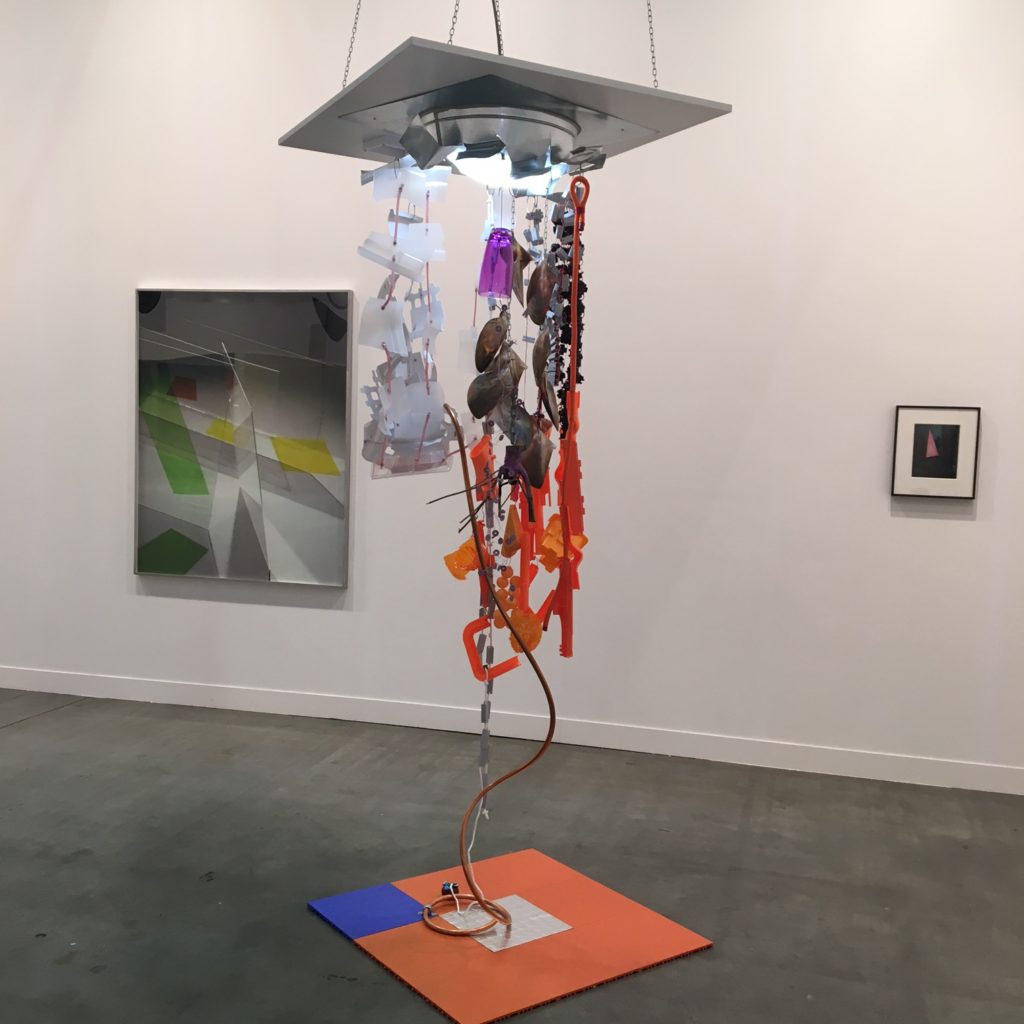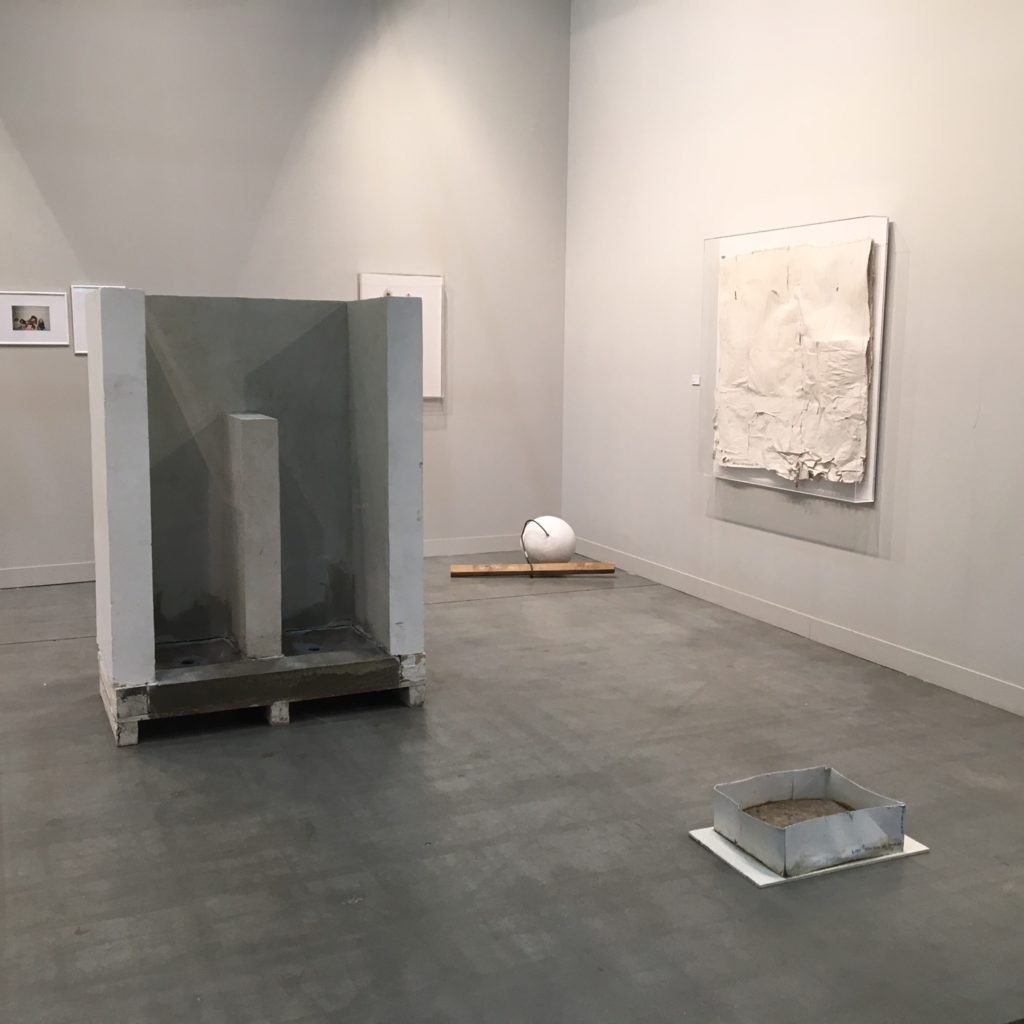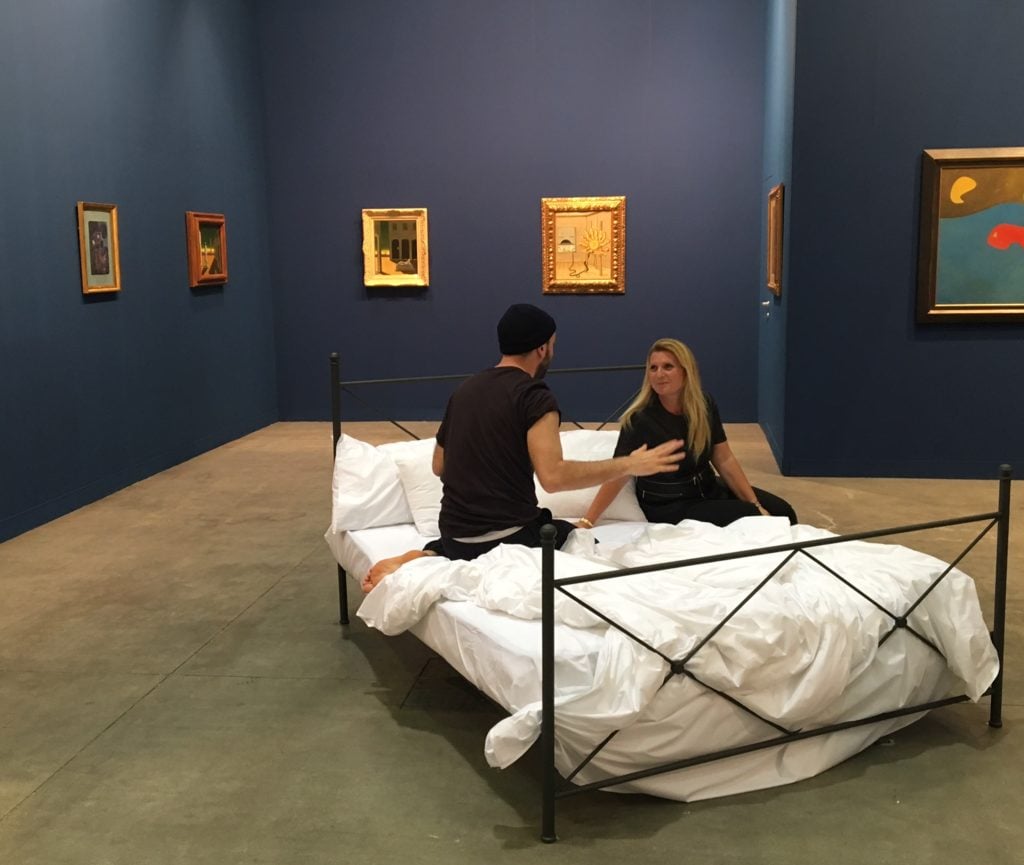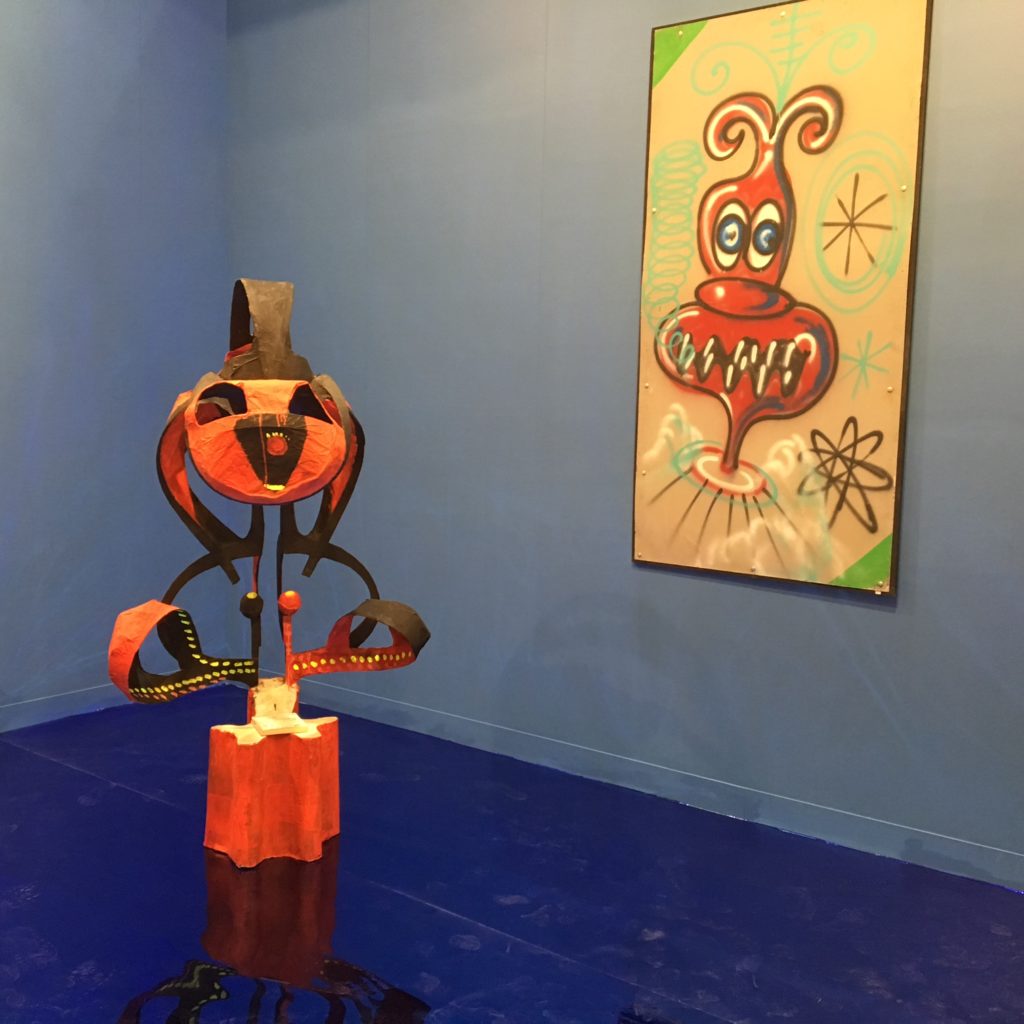Art Fairs
4 Things You Can’t Afford to Miss at miart 2017
From design collectibles to context-based conceptual pieces, this small fair has it all.

From design collectibles to context-based conceptual pieces, this small fair has it all.

Since his takeover was announced in 2016, it was clear that Alessandro Rabottini, the new director of the Milan International Fair of Modern and Contemporary Art, or miart, had big shoes to fill.
“Milan had everything, it was all there before, but Vincenzo de Bellis [the fair’s former director, now curator at the Walker Art Center] really created a network,” Italian writer and critic Barbara Casavecchia told artnet News at the fair’s preview yesterday. “He made it into a collective effort.”
In a city with an enviable wealth of historical museums, collectors, and galleries but no public contemporary art museums to its name, coordinating this collective effort is no small feat. It is up to the private foundations like Pirelli HangarBicocca, the Trussardi foundation, Fondazione Prada, or the Fondazione Carriero to bring contemporary art to a wider audience.
And the fair, following the complete makeover that de Bellis had given it, managed to pull together the city’s private and public institutions to collaborate and create the scene’s palpable buzz.
With not only the fair’s reputation but that of the entire city at stake, the question remained: what can the new director bring to the table? Attracting more international attention seems key.
Rabottini made slight tweaks to the fair’s curated sections, and enhanced the number of invited speakers, pulling in big names such a Kaspar König and Elmgreen & Dragset to a series of panels discussing the global biennials and their impact. Envisioning new things for miart, he also managed to give the endowment for awards a sizeable boost through new collaborations, catapulting the fair to the position of a co-producer of future art works.
Here are some of the highlights from Rabottini’s first edition:

Barbara Kasten and Jessica Stockholder, presented by Bortolami and Galleria Raffaella Cortese at the “Generations” section, miart 2017. Photo by Hili Perlson.
What: Barbara Kasten & Jessica Stockholder
Where: at the “Generations” section, curated by Douglas Fogle and Nicola Lees
Presented by: Bortolami, New York and Rafaella Cortese, Milan
“Though we would always say hello to each other at openings, it was only last year that we decided it was time to become better acquainted,” Kasten writes in the statement accompanying the joint presentation, describing how the fellow Chicagoans had visited each other’s studios recently, only to find out shortly after that, coincidentally, the curators of the “Generations” sector at miart wanted to present them together.
Here, Kasten’s meticulously built stage-size compositions and the intensity of light and color in the photographs she takes of them reverberate in Stockholder’s sculptures, with their unexpected materiality and erratic forms. The shared sensibilities in the distinct work of Kasten (born in 1936) and Stockholder (born in 1959) are in fact so pronounced that it is remarkable that they have only been paired together now.
While most of the photographs by Kasten shown here are from the early 1980s, (and cost around $20,000) a more recent work titled Transposition 14, from 2014, that deals with the aging of matter, is brilliantly paired with a lighting sculpture by Stockholder, which vaguely resembles a giant wind chime (going for €45,000.)
“We are both involved in asking questions about the limits of the forms that contain our work,” writes Stockholder of this artistic dialogue. “At the same time, we care deeply for the inventive and evocative space of the picture, and how that space has the capacity to reify emotional life.”

Gregor Schneider, presented by Guido Costa Projects at the “Decades” section, miart 2017. Photo by Hili Perlson.
What: Solo booth by Gregor Schneider
Where: at the “Decades” section, curated by Alberto Salvadori
Presented by: Guido Costa Projects, Turin
Will 2017 be the year that Gregor Schneider makes his triumphant return? With a solo exhibition that has just recently closed at the Bundeskunsthalle, the Art and Exhibition Hall of the Federal Republic of Germany in Bonn, Schneider’s sometimes uneasy work is pushing its way back into the public eye.
The German artist’s ongoing, merzbau-like work, Totes Haus (Dead House)—which is the artist’s parents’ house that he’s been altering and rebuilding since 1985, when he was only 16 years old—was selected by the curator as a representative of the 1990s in the fair’s “Decades” section. The entire house was shown at the German Pavilion in the 2001 Venice Biennale, some five years after dealer Guido Costa, together with a private collector, had started buying every available work by Schneider that they could come across.
With the collector having recently passed away, Costa is interested in placing Schneider’s work in institutional collections. “I’m keeping the prices realistic,” he told artnet News. Prices for photographic works start at €15,000, and a large concrete pissoir, titled Zwei Löcher (Two Holes), goes for €80,000.
“I want to bring attention to someone that for no reason has been forgotten by the market,” he says, admitting however that Schneider’s temperament and troubled, short-lived work relations with New York dealer Barbara Gladstone in the early 2000s may have been enough of a reason for that.
“I see him as an artist firmly based in the tradition of German and Austrian sculpture,” he adds, explaining that his fascination with Schneider’s work has to do with the artist’s obsession with making his own life the artwork itself.

“We, Dreaming,” a presentation by Nahmad Projects in collaboration with Riccardo Buscarini at miart 2017. Photo by Hili Perlson
What: Performance by choreographer Riccardo Buscarini, paintings by Max Ernst & Giorgio de Chirico
Where: “On Demand” section for context-based works, curated by Oda Albera
Presented by: Nahmad Projects, London
A new section at the fair, called “On Demand,” focuses on context-based art that requires non-passive viewers. The London gallery Nahmad Projects interpreted this in collaboration with choreographer Riccardo Buscarini, who built a situation-specific performance around the gallery’s presentation.
A double bed stands at the center of the booth and Buscarini in it, sometimes dancing, half reclined. Hung against a calming blue background, some nine oneiric paintings by Max Ernst and Giorgio de Chirico (who, by the way, could be hailed the secret star at the fair, with works by him popping up at countless booths across all sections) adorn the walls. The price range begins at around £200,000 and goes up to £2.5 million for the paintings, while Buscarini’s performance is not for sale.
To activate the work, a viewer must sit down next to him in bed. Buscarini, soft spoken and gesticulating elegantly, would begin to relate a dream. “I am looking down into a sink filled with water, and the water is dense, like blue paint. I dip my hands in it,” he tells me, and continues to describe his metamorphosis, from the effect of the paint on his hands, until he transforms into a bird. A glance behind his shoulder reveals a similar scene: his “dream” is in fact his description of Max Ernst’s Monument aux oiseaux (1927).
Resistant at first to what could have been a kitschy trap, I find myself moved by his interpretation of the painting, and the new perspective offered on it.

Riccardo Dalisi and Kenny Scharf, presented by Erastudio Apartment Gallery, “Objects” section at miart 201. Photo Hili Perlson
What: Presentation by Nanda Vigo
Where: “Object” section, curated by Domitilla Dardi
Presented by: Erastudio Apartment Gallery, Milan
If there’s one thing that sets miart apart from most other fairs is its inclusion of galleries dedicated to collectible design. This approach makes perfect sense here, where collectors pay attention to the way the art on their walls combines with the other objects in their spaces. Erastudio Apartment Gallery, in a booth curated by designer Nanda Vigo, presents a panel by Kenny Scharf, from his works for the 1984 Venice Biennale, set in charming dialogue with Throne from 1974, by Riccardo Palisi—a rare object in color by the designer.
On the left side of the booth, an installation of wooden chairs includes a natural wood piece by Palisi; another by Ugo Marano, called San Picasso (1978) which resembles an arrow-topped musical instrument; and Urano Palma’s perforated chair from 1979, all for undisclosed prices. A blue pouf by Vigo is three-tiered: atop a blue velour cushion set on a pedestal, two plastic dinosaurs guard the scene.